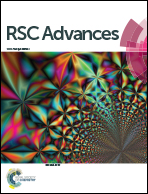Nonlinear optical response mechanism of noncentrosymmetric lead borate Pb6[B4O7(OH)2]3 with three crystallographically independent [B4O7(OH)2]4− chains†
Abstract
The noncentrosymmetric lead borate Pb6[B4O7(OH)2]3 has been synthesized by hydrothermal method with a yield of ∼85% based on Pb. It structurally features three crystallographically independent [B4O7(OH)2]4− helical chains with B12O29 fundamental building blocks (FBBs), which is unique in borate system. It has a wide transparency range from UV to NIR with the shortwave cut-off edge about 260 nm. The phase-matching second harmonic generation (SHG) response at 1064 nm fundamental wave was identified by the Kurtz–Perry method. First principles calculations on the band structure and partial density of states (PDOS) show that the title compound has a direct band gap determined by the interaction between lead and oxygen atoms. Stereochemically active lone pair lead cations and the BO3 groups with π-conjugated system make main contribution to the nonlinear optical (NLO) effect according to the SHG-density method.
![Graphical abstract: Nonlinear optical response mechanism of noncentrosymmetric lead borate Pb6[B4O7(OH)2]3 with three crystallographically independent [B4O7(OH)2]4− chains](/en/Image/Get?imageInfo.ImageType=GA&imageInfo.ImageIdentifier.ManuscriptID=C6RA23193D&imageInfo.ImageIdentifier.Year=2016)

 Please wait while we load your content...
Please wait while we load your content...